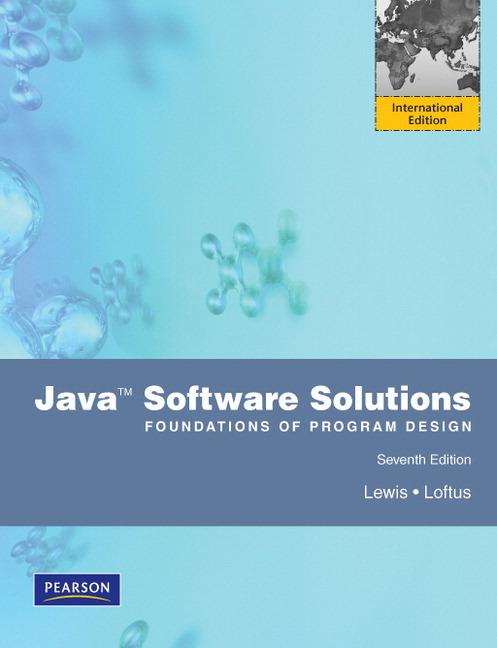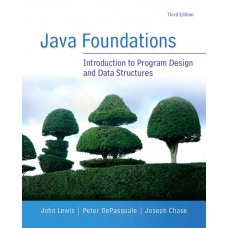Test Bank for Java Software Solutions 7th Edition (International Edition). John Lewis / William Loftus
$35.00 Original price was: $35.00.$26.50Current price is: $26.50.
Test Bank for Java Software Solutions 7th Edition (International Edition). John Lewis / William Loftus
Instant download Test Bank for Java Software Solutions 7th Edition (International Edition). John Lewis / William Loftus pdf docx epub after payment.

Product details:
- ISBN-10 : 0132149184
- ISBN-13 : 978-0132149181
- Author: John Lewis
Java Software Solutions teaches a foundation of programming techniques to foster well-designed object-oriented software. Heralded for its integration of small and large realistic examples, this worldwide best-selling text emphasizes building solid problem-solving and design skills to write high-quality programs. MyProgrammingLab, Pearson’s new online homework and assessment tool, is available with this edition. Subscriptions to MyProgrammingLab are available to purchase online or packaged with your textbook (unique ISBN). Use the following ISBNs to purchase MyProgrammingLab:Java Software Solutions: Foundations of Program Design & MyProgrammingLab with Pearson eText Student Access Code Card for Java Software Solutions, 7/E ISBN:0132760770This package includes the Java Software Solutions, textbook, an access card for MyProgrammingLab, and a Pearson eText student access code card for
Table of contents:
Chapter 1 Introduction 1 1.1 Computer Processing 2 Software Categories 3 Digital Computers 5 Binary Numbers 7 1.2 Hardware Components 10 Computer Architecture 10 Input/Output Devices 12 Main Memory and Secondary Memory 13 The Central Processing Unit 17 1.3 Networks 19 Network Connections 19 Local-Area Networks and Wide-Area Networks 21 The Internet 22 The World Wide Web 24 Uniform Resource Locators 25 1.4 The Java Programming Language 26 A Java Program 27 Comments 29 Identifiers and Reserved Words 31 White Space 33 1.5 Program Development 35 Programming Language Levels 36 Editors, Compilers, and Interpreters 38 Development Environments 40 Syntax and Semantics 41 Errors 42 1.6 Object-Oriented Programming 43 Problem Solving 44 Object-Oriented Software Principles 45 Chapter 2 Data and Expressions 61 2.1 Character Strings 62 The print and printlnMethods 62 String Concatenation 64 Escape Sequences 66 2.2 Variables and Assignment 69 Variables 69 The Assignment Statement 71 Constants 73 2.3 Primitive Data Types 73 Integers and Floating Points 74 Characters 75 Booleans 77 2.4 Expressions 77 Arithmetic Operators 78 Operator Precedence 78 Increment and Decrement Operators 83 Assignment Operators 84 2.5 Data Conversion 85 Conversion Techniques 87 2.6 Interactive Programs 88 The ScannerClass 88 2.7 Graphics 93 Coordinate Systems 94 Representing Color 95 xx CONTENTS CONTENTS xxi 2.8 Applets 96 Executing Applets Using the Web 98 2.9 Drawing Shapes 99 The GraphicsClass 99 Chapter 3 Using Classes and Objects 113 3.1 Creating Objects 114 Aliases 116 3.2 The StringClass 118 3.3 Packages 121 The import Declaration 122 3.4 The RandomClass 124 3.5 The MathClass 127 3.6 Formatting Output 130 The NumberFormatClass 130 The DecimalFormatClass 133 The printfMethod 135 3.7 Enumerated Types 135 3.8 Wrapper Classes 138 Autoboxing 141 3.9 Components and Containers 141 Frames and Panels 142 3.10 Nested Panels 145 3.11 Images 148 xxii CONTENTS Chapter 4 Writing Classes 155 4.1 Anatomy of a Class 156 Instance Data 161 UML Class Diagrams 162 4.2 Encapsulation 163 Visibility Modifiers 164 Accessors and Mutators 165 4.3 Anatomy of a Method 166 The returnStatement 167 Parameters 169 Local Data 170 Bank Account Example 171 4.4 Constructors Revisited 175 4.5 Graphical Objects 175 4.6 Graphical User Interfaces 184 4.7 Buttons 185 4.8 Text Fields 189 Chapter 5 Conditionals and Loops 201 5.1 Boolean Expressions 202 Equality and Relational Operators 203 Logical Operators 204 5.2 The ifStatement 207 The if-elseStatement 209 Using Block Statements 212 The Conditional Operator 217 Nested ifStatements 218 CH004_TOC.qxd 4/7/04 5:56 PM Page xxii CONTENTS xxiii 5.3 Comparing Data 220 Comparing Floats 220 Comparing Characters 221 Comparing Objects 222 5.4 The switchStatement 223 5.5 The whileStatement 227 Infinite Loops 232 Nested Loops 234 Other Loop Controls 237 5.6 Iterators 238 Reading Text Files 239 5.7 The doStatement 242 5.8 The forStatement 245 Iterators and forLoops 249 Comparing Loops 251 5.9 Drawing with Loops and Conditionals 251 5.10 Determining Event Sources 254 5.11 Dialog Boxes 260 5.12 More Button Components 263 Check Boxes 264 Radio Buttons 267 xxiv CONTENTS
People also search:
which software is used for java
java software solutions foundations of program design
|
in which software we can run java program
|
java is used for which application
|
java software examples
|
You may also like…
Solution Manual
Solution Manual for Java Foundations, 3/E 3rd Edition John Lewis, Peter DePasquale, Joe Chase
Solution Manual
Solution Manual for Java Foundations, 3/E – John Lewis, Peter DePasquale & Joe Chase
Solution Manual
Solution Manual












